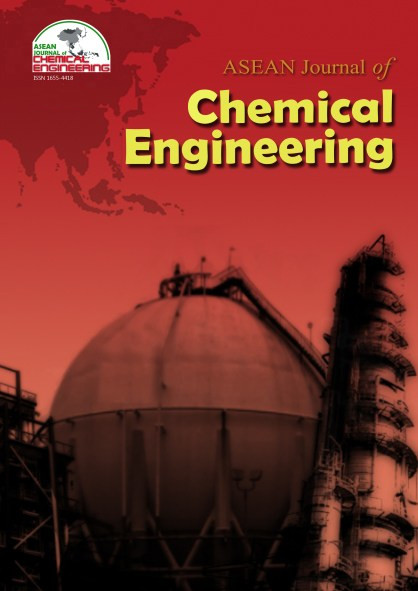Heating Characteristics of Palm Oil Industry Solid Waste and Plastic Waste Mixture using a Microwave Oven
Abstract
A microwave thermogravimetric analyzer was used to measure the characteristics of a mixture of palm oil solid waste (fiber, shell, and empty fruit bunch) and polyethylene terephthalate (PET). In the study, the range of palm oil solid waste composition ratios to PET used was 100:0, 75:25, 50:50, 25:75, and 0:100 (by weight). The study included the influence of the quality of raw material on the heating process. The mixture of palm oil solid waste (fiber, shell, and empty fruit bunch) and PET proved to impact the heating rate, mass-loss rate, and energy consumption. Based on the observation, empty fruit bunch-PET mixture had the highest heating rate (average 1.5039oC/s) than shell (average 0.6058oC/s), and fiber (0.9119oC/s) and also had the highest mass-loss rate (average 0.0253 g/s). The highest biomass (shell, empty fruit bunch, and fiber) and PET composition ratio give the highest rate of heating rate (average 1.8264oC/s) and mass-loss rate (average 0.02875 g/s). In addition, the increasing ratio of fixed carbon and material density will impact the increasing heating rate and mass-loss rate and decrease energy consumption. Therefore, fixed carbon and material gaps significantly affect the heating rate.
References
2. Anuar Sharuddin, S. D., Abnisa, F., Wan Daud, W. M. A., and Aroua, M. K. (2016). "A review on pyrolysis of plastic wastes," Energy Convers. Manage., 115, 308–26.
3. Barneto, A. G., Carmona, J. A., Gálvez, A., and Conesa, J. A. (2009). "Effects of the composting and the heating rate on biomass gasification," Energy Fuels., 23 (2), 951–7.
4. Beneš, H., Slabá, J., Walterová, Z., and Rais, D. (2013). "Recycling of waste poly(ethylene terephthalate) with castor oil using microwave heating," Polym. Degrad. and Stab., 98/11, 2232–43.
5. BPPT. (2014). Pengembangan Energi untuk Mendukung Program Substitusi BBM. (A. Sugiyono, Anindhita, and M. S. Boedoyo, Eds) Outlook Energi Indonesia., Vol. 1. Pusat Teknologi Pengembangan Sumberdaya Energi (PTPSE).
6. Chemat, F., and Poux, M. (2001). "Microwave assisted pyrolysis of urea supported on graphite under solvent-free conditions," Tetrahedron Letters., 42 (22), 3693–5.
7. Chen, W. H., Kuo, P. C., Liu, S. H., and Wu, W. (2014). "Thermal characterization of oil palm fiber and eucalyptus in torrefaction," Energy, 71, 40–8.
8. Ditjenbun. (2018). ‘Statistik Perkebunan Kelapa Sawit’. Retrieved from (ditjenbun.pertanian.go.id)
9. Filly, A., Fernandez, X., Minuti, M., Visinoni, F., Cravotto, G., and Chemat, F. (2014). "Solvent-free microwave extraction of essential oil from aromatic herbs : From laboratory to pilot and industrial scale," Food Chemistry., 150, 193–8.
10. Garrett, M., and Arif, R. (2019). Indonesia Oilseeds and Products Annual 2019. United States Departement of Agricalture, Foreign Agricalture Service. Retrieved from (www.fas.usda.gov)
11. Halim, N. H. A., Saleh, S., and Samad, N. A. F. A. (2019). "Effect of gasification temperature on synthesis gas production and gasification performance for raw and torrefied palm mesocarp fibre," ASEAN J. Chem. Eng., 19 (2), 120–9.
12. Hambali, E., and Rivai, M. (2017). "The Potential of Palm Oil Waste Biomass in Indonesia in 2020 and 2030," IOP Conference Series: Earth and Environmental Science., 65/1.
13. Huang, Y. F., Chiueh, P. Te, and Lo, S. L. (2016). "A review on microwave pyrolysis of lignocellulosic biomass," Sustainable Environ. Res., 26 (3), 103–9.
14. Miandad, R., Barakat, M. A., Aburiazaiza, A. S., Rehan, M., Ismail, I. M. I., and Nizami, A. S. (2017). "Effect of plastic waste types on pyrolysis liquid oil," International Biodeterioration and Biodegradation., 119, 239–52.
15. Motasemi, F., and Afzal, M. T. (2013). "A review on the microwave-assisted pyrolysis technique," Renewable and Sustainable Energy Reviews., 28, 317–30.
16. del Mundo, I. C., Cavarlez, J. M., Pe, A. M., and Roces, S. (2018). "Microwave assisted glycerolysis of neem oil," ASEAN J. Chem. Eng., 18 (1), 17–23.
17. Namazi, A., Allen, D., and Jia, C. (2015). "Microwave-assisted pyrolysis and activation of pulp mill sludge," Biomass and Bioenergy, 73.
18. Namazi, A. B., Allen, D. G., and Jia, C. Q. (2015). "Probing microwave heating of lignocellulosic biomasses," J. Anal. Appl. Pyrolysis., 112, 121–8.
19. Owusu, P. A., and Asumadu-Sarkodie, S. (2016). "A review of renewable energy sources, sustainability issues and climate change mitigation," Cogent Engineering., 3 (1).
20. Panwar, N. L., Kaushik, S. C., and Kothari, S. (2011). "Role of renewable energy sources in environmental protection: A review," Renewable and Sustainable Energy Rev., 15 (3), 1513–24.
21. Somerville, M., and Jahanshahi, S. (2015). "The effect of temperature and compression during pyrolysis on the density of charcoal made from Australian eucalypt wood," Renewable Energy., 80, 471–8.
22. Susanto, H., and Syamsuriputra, ali ahchmad. (2004). "Utilization of sugars in hydrolysate from oil palm empaty fruit bunches for ethanol fermentation using pichia stipitis CBS 5773," ASEAN J. Chem. Eng., 4 (2), 40–7.
Copyright holder for articles is ASEAN Journal of Chemical Engineering. Articles published in ASEAN J. Chem. Eng. are distributed under a Creative Commons Attribution-NonCommercial 4.0 International (CC BY-NC 4.0) license.
Authors agree to transfer all copyright rights in and to the above work to the ASEAN Journal of Chemical Engineering Editorial Board so that the Editorial Board shall have the right to publish the work for non-profit use in any media or form. In return, authors retain: (1) all proprietary rights other than copyright; (2) re-use of all or part of the above paper in their other work; (3) right to reproduce or authorize others to reproduce the above paper for authors’ personal use or for company use if the source and the journal copyright notice is indicated, and if the reproduction is not made for the purpose of sale.



